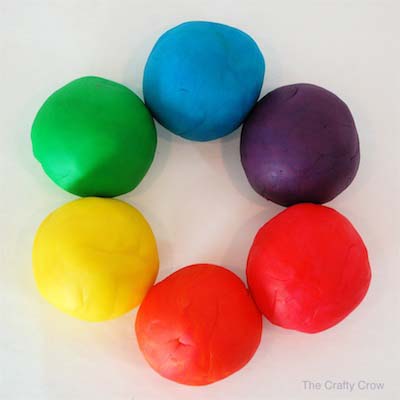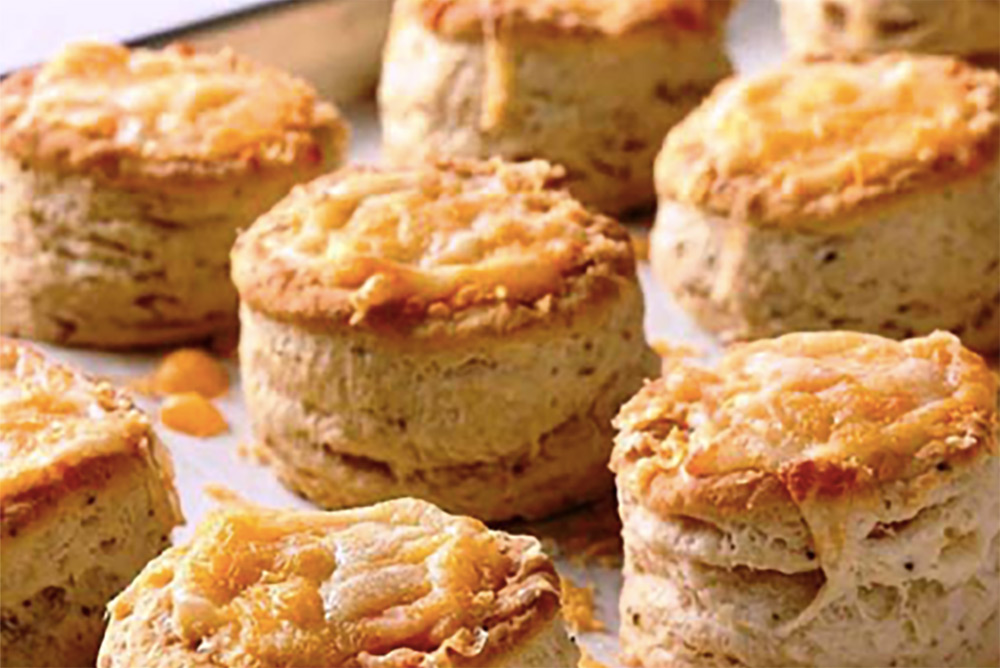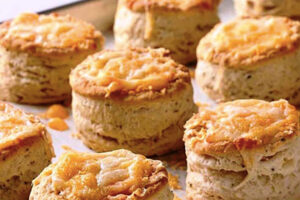After owning one of the best cooking stores in the US for 47 years—La Cuisine: the Cook’s Resource, in Alexandria, Virginia—Nancy Pollard now writes Kitchen Detail, a blog about food in all its aspects—recipes, film, books, travel, superior sources and food-related issues. She and her husband, the Wine Maniac, have recently moved to Italy.
NOT AN astonishing amount has been written about the discovery of sodium acid pyrophosphate by Byron H. Smith, a Bangor, Maine, chemist in the 1940s. But Smith’s creation has proved miraculous, dramatically changing the fortunes of countless bakers, including numerous clients of La Cuisine—and me. Cream of tartar, when mixed 2:1 with baking soda, creates what we call baking powder.
Traditional cream of tartar is a fortuitous by-product of the production of champagne and wine. Cream of tartar was shipped to the US and other countries from France—until the Nazis interrupted supply lines. Byron H. Smith was one of many in the US who tried to dream up substitutes for wartime shortages. He found a close replacement for cream of tartar in sodium pyrophosphate (a mineral acid), mixed it with re-dried cornstarch, and called the resulting leavening agent Bakewell—because that’s exactly what it did.
Try It, You’ll Like It
The product contains no dairy: The “cream” in its name refers to its use in traditional Maine cream biscuits. Mr. Smith added the cornstarch to prevent moisture absorption. If used in a 2:1 ratio with baking soda, it is an excellent replacement for baking powder. It is obviously GMO and gluten free. There is no aluminum added to it, which sometimes gives a tinny taste to baked goods made with other baking powders. Currently, you can get Bakewell Cream baking powder with no cornstarch as well, if that additive is a problem in your diet. No one can quite figure out why Smith’s invention gives a superior baking result. For me, no explanation necessary. I quit using other baking powders the minute a customer gave me Bakewell Cream as a gift almost 20 years ago.
Not With Meringue, Though
Bakewell Cream Baking Powder won’t function as a substitute for cream of tartar when beating egg whites for meringues or angel cakes. Traditional cream of tartar quickly reduces the pH factor of egg whites, thereby warding off browning. Sodium pyrophosphate, on the other hand, becomes acidic only when heated in the presence of water. So you won’t get the white fluffy meringue result with Bakewell Cream that you would with traditional cream of tartar. It’s worth noting that the Bakewell product is proudly manufactured in small batches in Maine and not from overseas sources. And it is interesting that two of the largest commercial buyers of Bakewell Cream are Hannaford (of Hannaford Baking Powder fame) and King Arthur Flour, whose recipe for biscuits without buttermilk is in the link.
Bakewell Baking Powder Still Made In Maine
Mr. Smith’s wonderful discovery and his company are now under the aegis of The New England Cupboard, which is a specialty food- mix manufacturer and distributor located in Hermon, Maine. New England Cupboard was founded in 1995 and is currently owned and operated by Jim Collins, who proudly oversees the production of Bakewell, Winterport Company Dips and Mixes, and Jimbo’s Seasonings, Jake’s Treats, and Cook In The Kitchen. You can get the Bakewell Cream with or without the baking soda. The plain Bakewell Cream has a 4-year shelf life; with baking powder added, Bakewell Cream Baking Powder has an 18-month shelf life. I have both and have used the combined powder, and I’ve created my own mixture by adding baking soda to the Bakewell Cream. The results were equally good.
Having read about the cleaning powers of cream of tartar, I am planning on testing out the Bakewell Cream as a cleaning agent too, so stay tuned.
Bakewell Cream Biscuits
Yields 1½ to 2½ dozen biscuits, depending on biscuit size.
Recipe from The New England Cupboard.
Ingredients
4 cups all-purpose flour
4 teaspoons Bakewell Cream (NOT Bakewell Cream Baking Powder)
2 teaspoons baking soda
1 teaspoon salt
8 tablespoons cold unsalted butter, cut into pieces
1½ cups cold milk
Melted butter, optional
Instructions
- Preheat the oven to 475°F. Lightly grease a baking sheet, or line the sheet pan with parchment or a silicone mat (like Silpat).
- Whisk flour, Bakewell Cream, baking soda, and salt together in a bowl.
- With a pastry blender or your fingers, work the pieces of cold butter into the dry mixture until the mixture is crumbly (it’s okay if some pea-size bits of butter remain).
- Add the milk and stir until the mixture is moist.
- Turn the dough out onto a clean surface (I often use a Silpat silicone mat). Fold the dough over once or twice and pat it into a square (or round, if you prefer) that’s about ¾ inch thick.
- Cut the biscuits with a biscuit cutter and place them on the prepared baking sheet. At this point, you can brush the top of each biscuit with milk or melted butter.
- Bake in the preheated oven for 5 minutes. Then turn the oven off and leave the biscuits in there for 5 minutes more, or until they are golden-brown. Serve warm.
A Rainy Day Recipe for Children
We have included Jim Collins’s recipe for a homemade playdough using Bakewell Cream instead of cream of tartar. You and the kids of your choice can use India Tree Nature’s Colors Decorating Set to create shades that have no artificial additives. You can divide up the “dough” in three pans while it is in the soupy state and add colors. Or you can have your kids knead in the hues after the concoction has reached the “playdough” stage.
Aunt Ellen’s Fun Puddy

- 2 cups all-purpose flour
- 1 cup fine salt
- 4 teaspoons Bakewell Cream
- 2 cups water
- 2 tablespoons vegetable oil of your choice
- Food coloring (we suggest India Tree Nature’s Colors Decorating Set)
- You can make the dough in one saucepan and then knead in the colors, once the mixture becomes “dough,” or you can divide the mixture into saucepans while it is in its soupy stage and dye each batch in a different color.
- With a whisk or pastry cutter, mix together (the least expensive all-purpose) flour, salt, and Bakewell Cream.
- Pour into a saucepan and then add the water and oil. Stir regularly while the mixture cooks so that no lumps form.
- Cook over low heat until the mixture forms a ball. (Before it forms the ball stage, you can decide whether you want to add color while it is liquid or wait until later. At the latter point, you will have to allow it to cool somewhat before dividing and kneading in the colors.
- It can be kept in Ziploc bags in your fridge indefinitely.
- The India Tree colors will not give you the intensity of color that artificial colors will. But you can mix them to give you some astonishing variations. Each pack comes with red, yellow, and blue naturally derived colorants and working with them makes for a nice lesson on producing secondary colors with primary ones.





Yes. It is. I made it for my grandchildren in the states.
I’m going to try the “play dough” recipe with my granddaughters. Looks pretty safe!